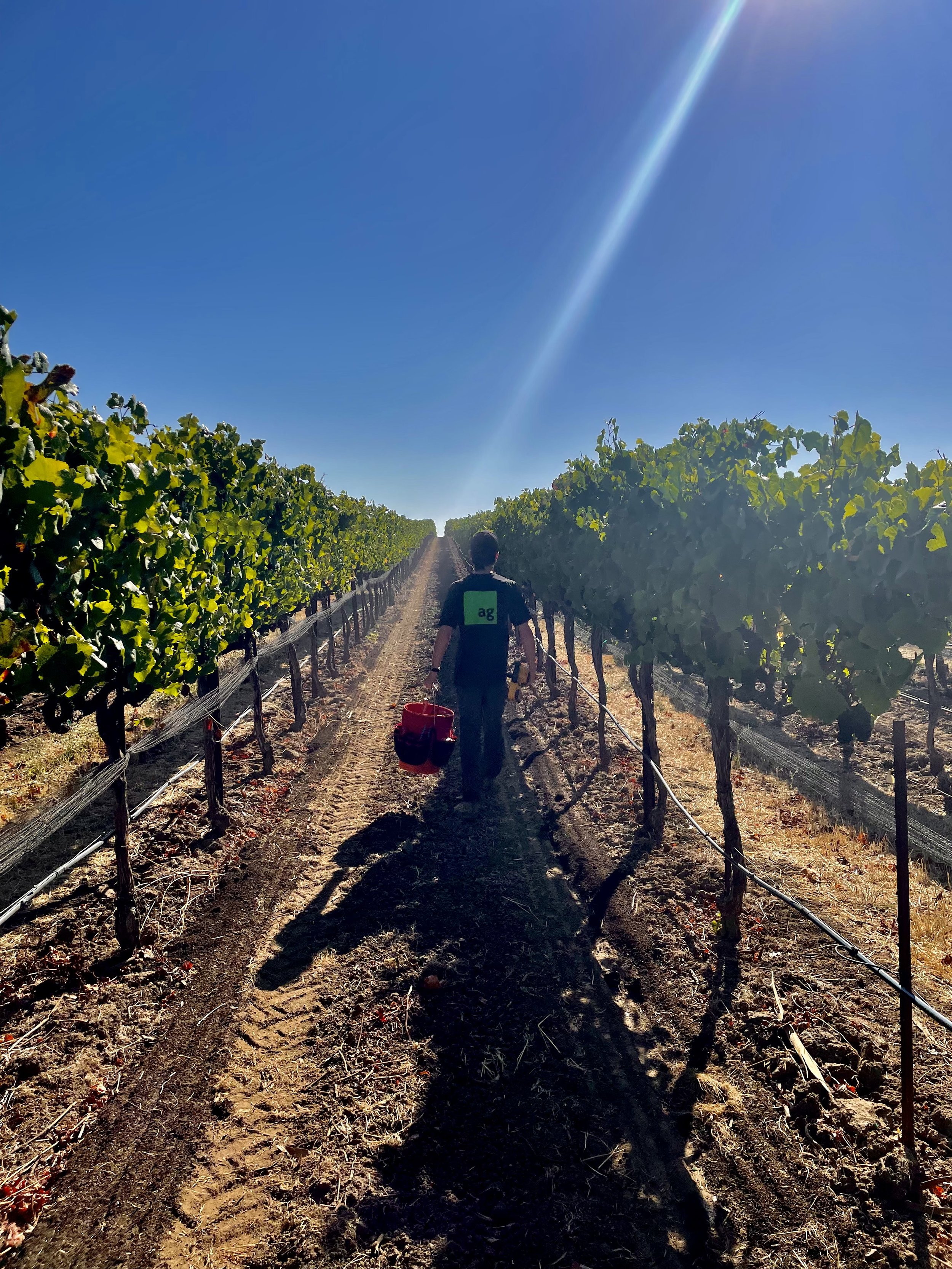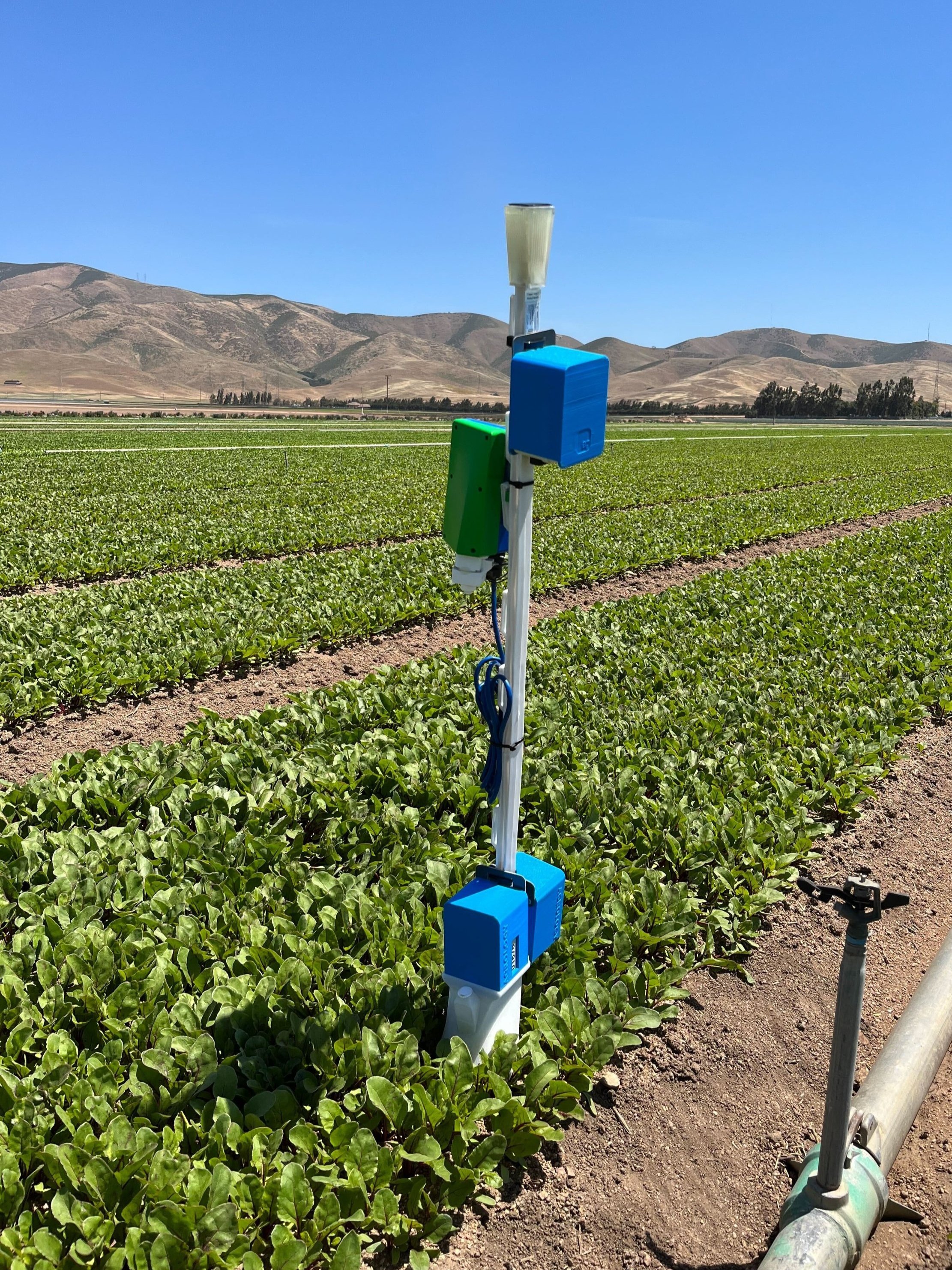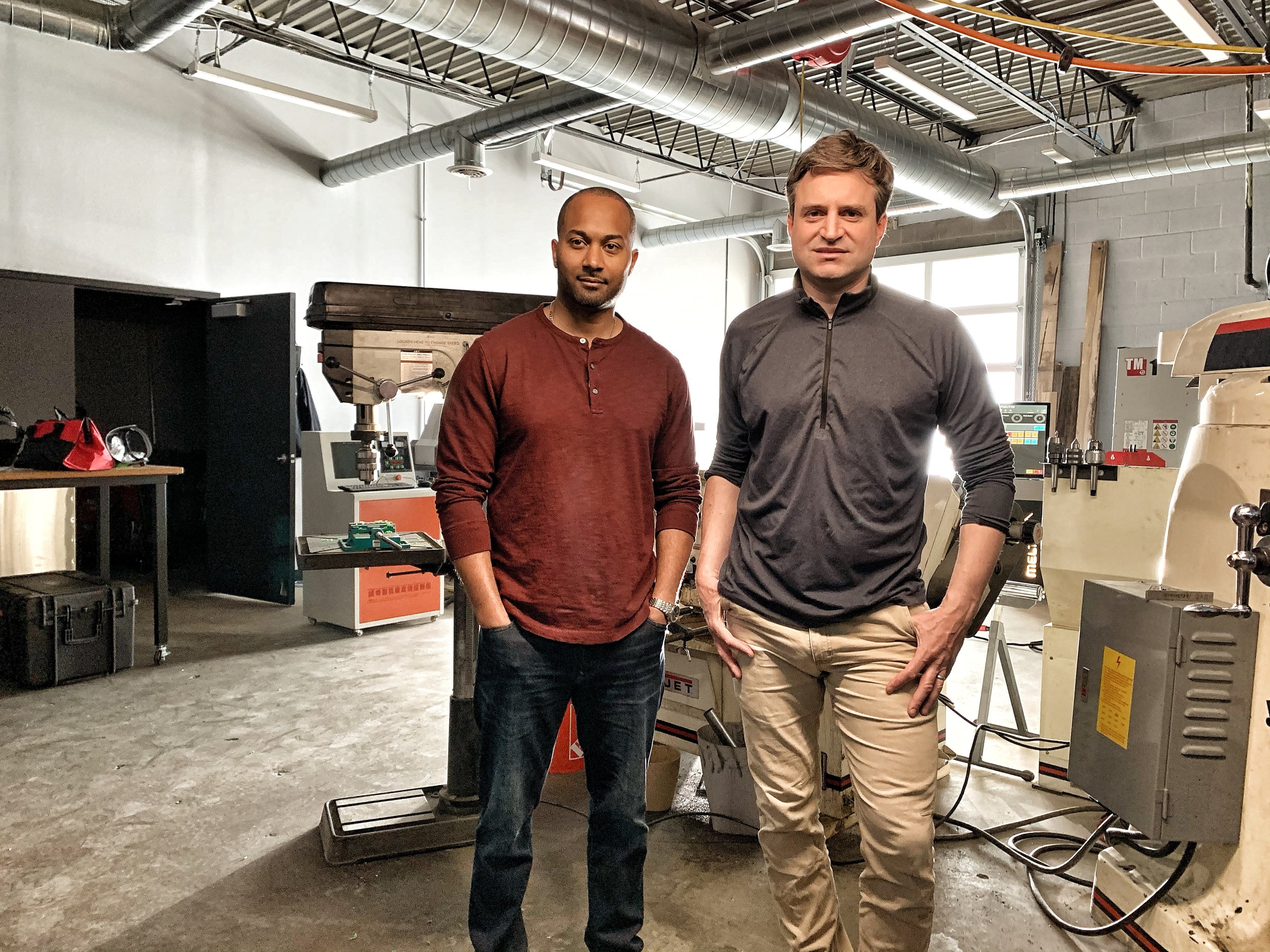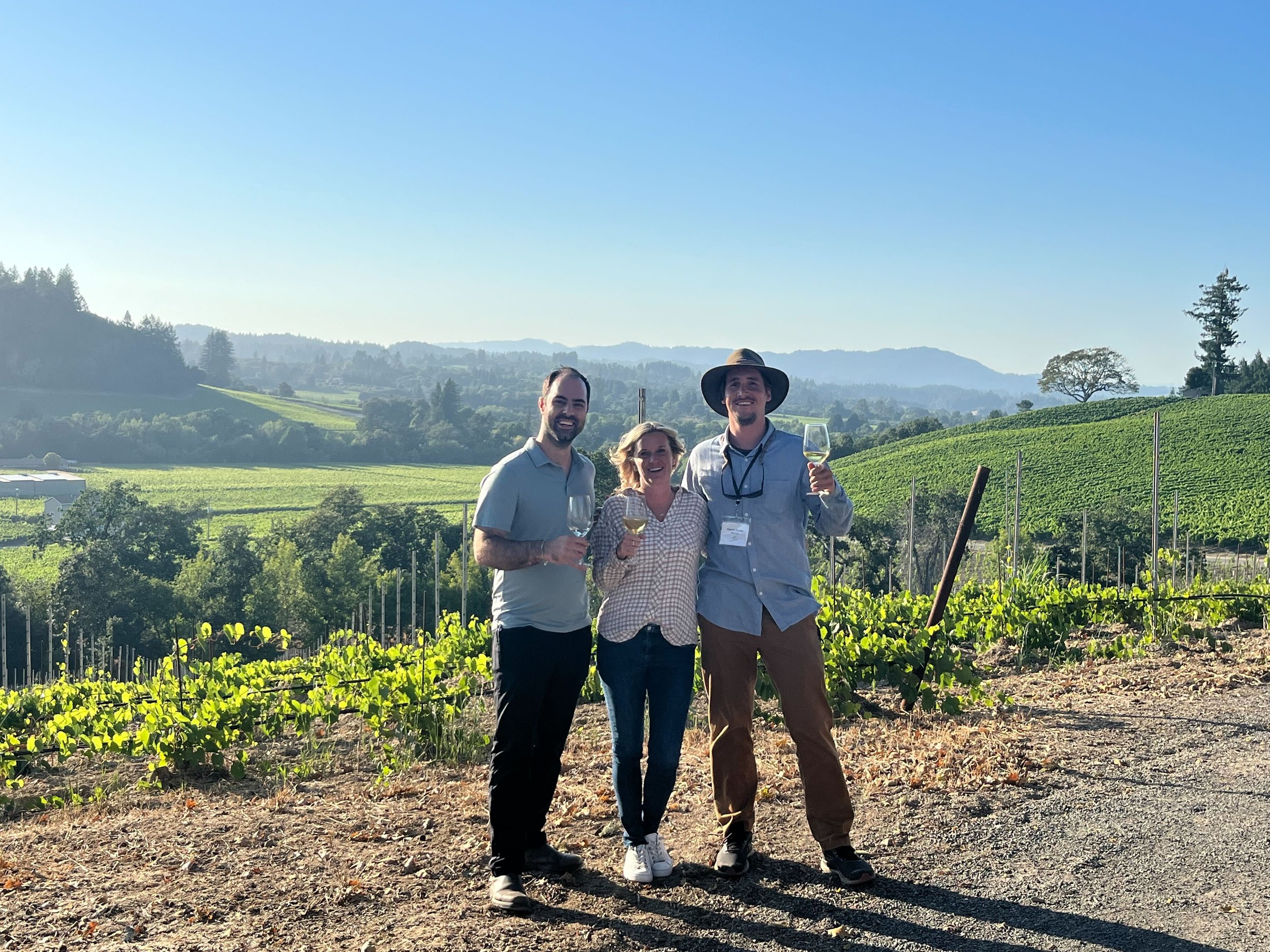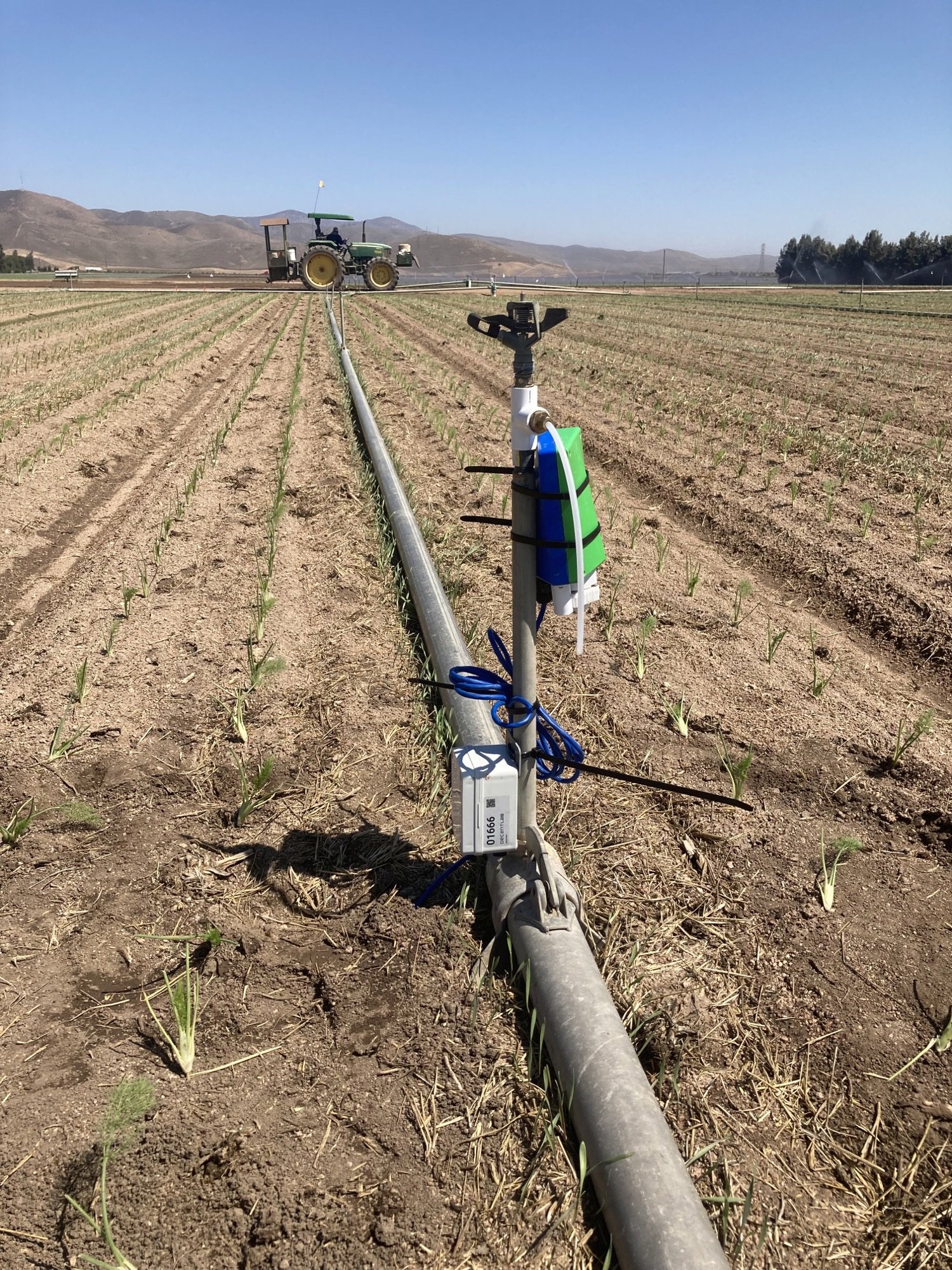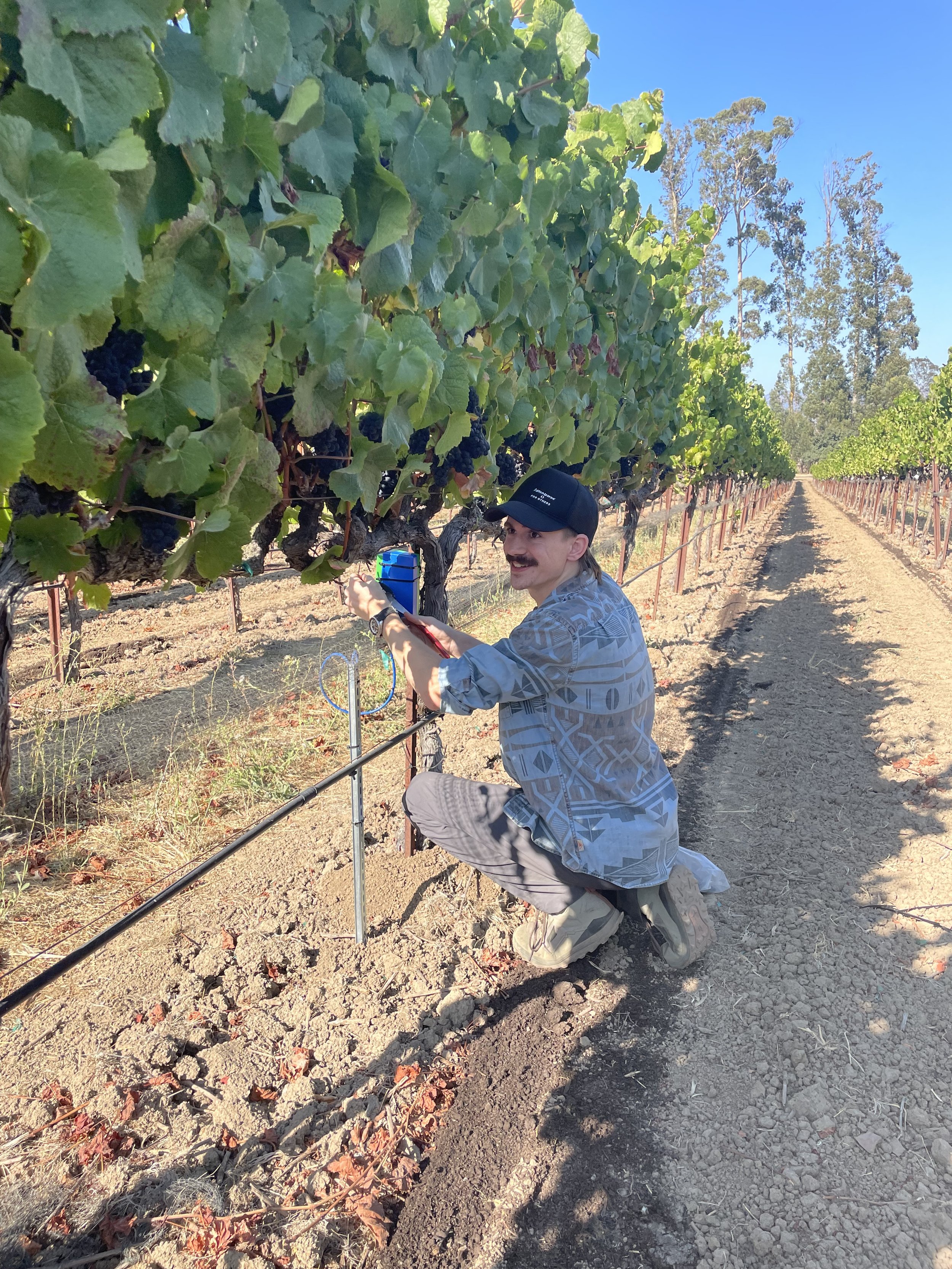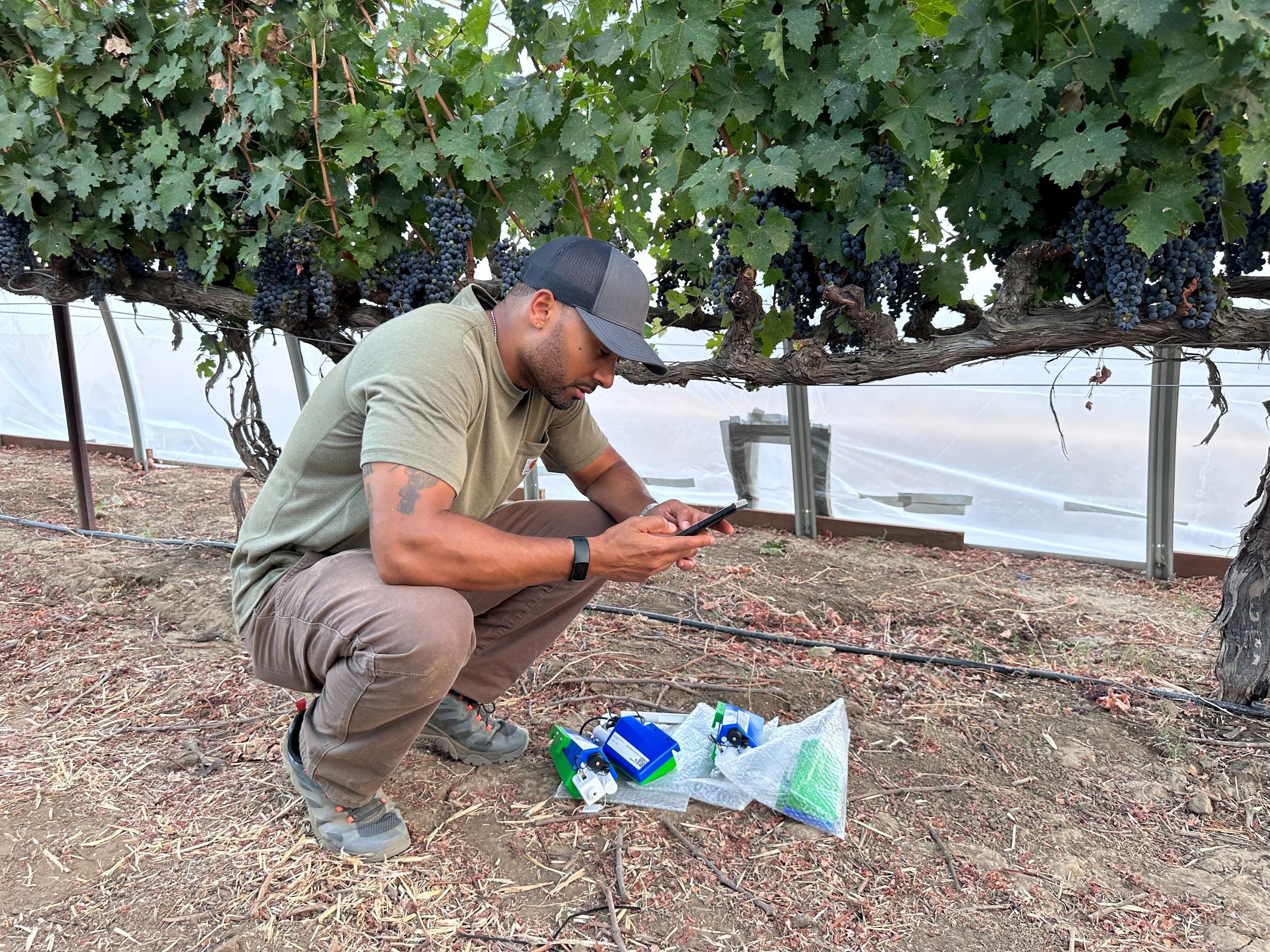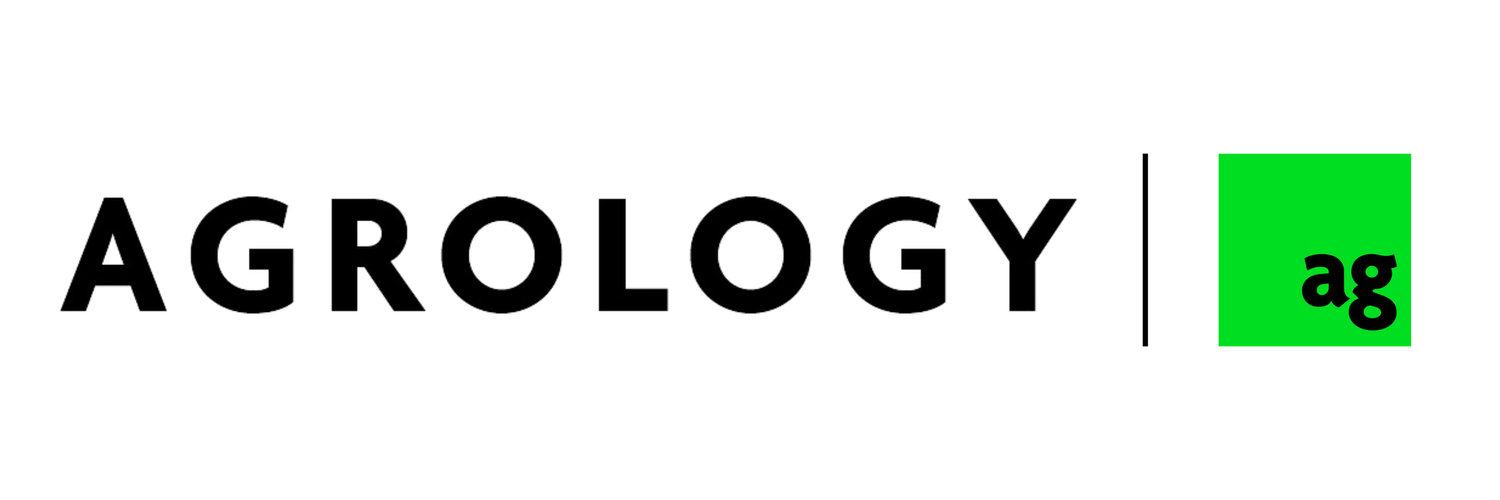We’re on a mission to give farmers the technology and insights they need to thrive.
Our Story.
The company’s founders, Adam Koeppel, Tyler Locke, and Kevin Kelly have a shared passion for building clean technology, helping humanity and helping the planet.
After spending almost a decade building agriculture sensors in his basement, Adam showed Tyler his prototypes for a low-cost Predictive Agriculture platform, based on machine learning. A long-time friend and colleague, Tyler was impressed. But knew he could make it even better.
Together, Adam and Tyler applied for a highly-selective National Science Foundation SBIR Award. They assumed it would take a few tries, and if they ever made it, they’d leave their jobs and start Agrology. To their great surprise, they won the grant on the first try and in 2019 Adam and Tyler left their corporate day jobs. Kevin joined them soon after.
Today, Agrology is a Public Benefit Corporation committed to protecting the economic viability of our farmers and the sustainability of our planet. While we experience a rapidly changing climate, the Agrology executive team remains committed to building technology that improves our world and keeps the farming community viable and sustainable, as the climate continues to change.
Agrology
-

Adam Koeppel
CO-FOUNDER, CEO
Adam is the CEO of Agrology. His motivation is growing enough food to feed the future world. He focuses on discovering customer problems, developing products to solve them, and designing business models to get products in customers’ hands. While growing up in California, Adam enjoyed working in his godparents apple orchard and visiting many Central Valley farms during family road trips. He also experienced many droughts. This led to his interest in agricultural optimization.
Adam has experience at multiple early stage companies as well as corporate research labs. His work on IoT connected cards will soon launch as the Capital One Presto Card. Adam has 48 granted patents and 69 applications under prosecution. Adam enjoys team sports, rowing, paddling and sailing, and designing and prototyping Agrology hardware.
-

Tyler Locke
CO-FOUNDER, CTO
Tyler’s interest in embedded systems and mission driven technological challenges led him to co-found Agrology.
Tyler has comprehensive experience of over 14 years as a hardware engineering professional, leading product R&D and manufacturing for IoT and medical device systems. Tyler has strong knowledge in all phases of product development, as well as experience developing a range of embedded devices such as infusion insulin pumps, energy monitoring systems, lighting control systems, embedded payment devices, and wireless IP security cameras.
As a hands-on team leader, Tyler has a proven track of building and managing strategic industry partnerships, leading cross-functional engineering teams, providing key technical contributions to innovation-driven product designs, and spearheading the implementation of both foreign and domestic supply chains and manufacturing services.
Tyler currently holds 60 approved US patents.
-

Kevin Kelly
CO-FOUNDER, HEAD OF SOFTWARE
Kevin received his B.S. in Electrical Engineering from Florida State University in 2010. Since then he has had multiple career paths driven by his interests, starting as an analog design engineer with a large government contractor. His early work experience exposed him to the "full stack" of hardware and software engineering as he would often be required to design and build not just the hardware but also the firmware and software UI.
His interest in the whole product led to his self-taught education in software development and eventual role as an iOS developer for a large bank. It didn't take long for his electrical engineering background to influence product development at the bank, and within 6 months he became the hardware and software developer of a new prototype credit card and its companion iOS app. Over the next several years Kevin continued to hone his software expertise and passion for finding new applications for computing at the edge, culminating in his co-founding of Agrology and development of the machine learning-based technology at its core. He currently has 23 patents, including one for an application of machine learning and computer vision.
-

Charlie Dubbe
HEAD OF REGENERATIVE PARTNERSHIPS
Charlie brings over 10 years of on the ground experience in regenerative and organic agriculture. He has been the COO at a variety of farms on the central coast of CA, managing commercial blueberry production, diversified veggie operations, and hemp seed production. He is the co-founder of ReCommon, a climate impact startup that creates public goods infrastructure to support community-held lands across the globe, such as the Regenerative Community Land Trust (RCLT) model.
At Agrology, Charlie leads regenerative partnerships and business development. With real-time, continuous soil respiration and carbon flux monitoring, Agrology allows the soil to speak, facilitating a more robust dialogue between farmers and their soil microbiomes. This empowers farmers to tie their practices to real-world soil health outcomes, and optimize their regenerative programs within their unique context. When not thinking about plants or soil life, you are likely to find Charlie surfing, kayaking, or hiking in the mountains around his home in Santa Cruz, CA.
-

Ian Ferguson
FIELD TECHNICIAN
Ian is a deeply curious person who has always followed his interests and passions. In 2020, he received his bachelor's degree in Editorial Journalism with a minor in computer science, and since then, he has developed a diverse skill set in many workplaces. He has worked in newsrooms, mortgage firms, and coffee shops and has strived to find creative solutions to each industry’s unique problems.
Over the past several years, Ian has worked for an organic produce and flower farm in Carmel Valley. Through this work, he developed a strong passion for sustainable, regenerative agriculture and has become driven to apply himself to the complex challenges in the field. In pursuit of this, Ian is working towards a B.S. in Computer Science to develop his technical skillset. He is honored to be a part of the Agrology team and to begin working towards a more sustainable agricultural future.
-

Richmond Holloway-III
ASSEMBLY TECHNICIAN
Richmond is passionate about solving complex problems and assisting in the deployment of high-quality IoT products. As Agrology's Assembly Technician, he works directly with our engineering team to produce electromechanical assemblies, conduct quality checks and inspections, and document assembly processes. He oversees Final assembly, testing, and provisioning for Agrology’s suite of environmental monitoring and sensing devices. Prior to Agrology, Richmond worked for Nordstrom and Throne Labs. He has extensive experience with electrical wiring of control boards using schematics and field related services.He holds a B.S. in electronics engineering technology from Southern University A&M College.
-

Christopher Kappelmann
SENIOR FIRMWARE ENGINEER
Christopher is a skilled firmware engineer with a B.S. in Electrical and Computer Engineering from Baylor University. He is passionate about building robust solutions at the intersection of the digital and physical worlds.
With experience working with startups in green technology and public safety, Christopher has a proven track record of success in developing innovative solutions that make a positive impact. Notable projects he has contributed to include an IoT irrigation system designed to reduce landscape water consumption and a low-cost situational awareness robot for first responders.
At Agrology, Christopher focuses on developing and supporting firmware that ensures the reliable operation of devices in the field. In his spare time, he enjoys getting outdoors to camp, hike, and experience nature.
-

Kristina McBrayer
HEAD OF OPERATIONS
Born and raised in the crucible of agriculture in Northern California, Kristina McBrayer is a pioneering force in Ag Tech. The former FFA leader and Chico State alumnus admires and identifies with farmers and growers and their commitment, work ethic, and resilience.
Kristina brings over 15 years of operations leadership and experience at an in-field sensor technology company. She is known for building resilient, scalable operations infrastructure and curating outstanding customer experiences. Kristina has a lengthy track record of leading startups and quickly growing organizations through critical improvements in customer engagement and efficiency.
As a lover of planet earth, animals, and passionate about sustainability, Kristina is excited to partner with Agrology’s team to make a tangible and immediate impact. As a mother, it is important to her to help preserve our planet for future generations. In her spare time, you’re likely to find her on a mountain adventure exploring nature, accumulating pets, or singing karaoke with her family and friends.
-

Holly Nuss
CHIEF OF STAFF, HEAD OF MARKETING COMMUNICATIONS
Holly brings over 20 years of experience in marketing, communications and corporate strategy. She brings invaluable wine industry experience and connections to the Agrology team. Holly came to Agrology from alcohol distributor, LibDib, where she served as the start-up’s chief of staff and head of marketing. Prior to LibDib she was the c-founder of beverage alcohol PR firm Teplin+Nuss. At Agrology, Holly handles brand strategy and development, internal and external communications, public relations, content strategy, social media strategy, and executive visibility.
Holly comes from a long line of almond, cherry, and wine grape growers. Growing up, she spent summers in California’s Central Valley, where she helped her grandparents and extended family with irrigation and harvests. An avid outdoors enthusiast, she spends her spare time in nature, or protecting our waterways and open spaces.
-

Jay Radochia
HEAD OF AGRIBUSINESS DEVELOPMENT
Jay brings 10 years of experience in technology startups, working in sales, partnerships and customer success. He is an equal parts problem solver, tinkerer, and storyteller and helped start and grow 3 companies across 3 different industries.
Since his first job as a farmhand at a CSA in Ipswich MA (Appleton Farms) Jay has been obsessed with growing vegetables, fruit, and raising animals. As an aspiring farmer, Jay was thrilled to join the Agrology team and to merge his experience with technology and his passion for agriculture.
Jay and Charlie lead the growth team at Agrology and hope to bring growers and their partners the data and tools they need to become more resilient, profitable and sustainable in this new era of precision and regenerative agriculture.
-

Dana Revallo
HEAD OF CUSTOMER SUCCESS
Dana Revallo brings over 18 years of experience in agriculture, project management, and organic farming to his role as Head of Customer Success at Agrology.
Growing up in the Midwest, Dana developed a deep appreciation for agriculture from a young age. With a diverse background in managing orchard crops, livestock, and row crops, Dana has managed multiple farms and served as Agricultural Development Director for a private investment group. In his current position, he leads efforts to onboard and support customers, helping them fully leverage Agrology's innovative sensor technology and data-driven solutions. Passionate about sustainability, Dana works to enhance customer experiences, improve operational efficiency, and build strong relationships with growers, helping them optimize farm management and productivity.
-

Caleb Webster
SOLUTIONS ARCHITECT
Caleb is Agrology's multi-talented Solutions Architect and is responsible for designing, implementing, and supporting scalable and efficient field operations solutions. A former Agrology Field Technician, Caleb graduated from high school early, with honors, and is currently pursuing a bachelor's degree in business.
A lifelong learner, he is a fan of electronics and the outdoors, making him the perfect fit for Agrology. Caleb appreciates the insight into startup life and collaborates with cross-functional teams and stakeholders to deliver an exceptional customer experience by ensuring Agrology’s hardware is adapted and functioning in all environments.
Scientific Advisors
-

Dr. Jessica Chiartas
SCIENTIFIC ADVISOR
Dr. Jessica Chiartas received her PhD in Soils & Biogeochemistry from the University of California, Davis. After her PhD, she served as a fellow with the Innovation Institute for Food and Health and is currently a postdoctoral scholar in the Department of Plant Sciences. Her research focuses on the long-term impacts of agricultural management on soil carbon (to a depth of 1+ meters), soil health and the provision of ecosystem services across a diversity of soils, climates, and production systems. Through participatory research and multi-stakeholder engagement, she seeks to develop communities of practice and marketplace infrastructure to support, incentivize and scale adoption of soil health/regenerative management.
Over the last five years, Jessica has supported businesses, brands, non-profits, and NGOs in developing bespoke monitoring programs to track the environmental, agronomic, and economic impacts of regenerative management; including Ben & Jerry’s, Simple Mills, Daily Harvest, Citizens of Humanity, Community Alliance with Family Farms, Fibershed, and Moonshot Snacks. She is President and Lead Scientist at RegenScore, an evidence-backed, place-based, scoring framework for assessing regenerative agriculture. Jessica is an advisor for the North Coast Soil Health Hub, LandCore USA, PlanetFwd, Crop/Range-C (and formerly Regenerative Organic Certification); serves on the ASA-CSA-SSSA Science Policy Committee; and represents UC Davis in the California Farm Demonstration Network. She is also founder/creator of Soil Life, a website and series of short videos and educational resources that inspire, empower, and engage young people in the many solutions to global challenges that lie right beneath their feet.
-

Chuck Schembre
SCIENTIFIC ADVISOR
Chuck Schembre is a Regenerative Specialty Crop consultant for Understanding Ag, and serves clients across a broad geographical range in the United States, with an emphasis on California and the West. He specializes in orchards, vineyards, and diversified vegetable cropping systems, and has experience working with small grains, hay crops, and pastures. Chuck provides a diversity of services to his clients, addressing each client’s specific needs and opportunities to begin their regenerative journey, and advance strategies to take their regenerative practices to the next level. As with all the consultants on the UA team, Chuck focuses on building soil health and farm ecosystem function through the implementation of UA’s 6-3-4 rules and principles, and he provides additional expertise in soil health analysis, regenerative crop fertility, biological disease and pest management, advance horticulture practices, input reduction strategies, and ecosystem restoration. Chuck also assists clients in small livestock integration, specializing in orchard and vineyard livestock integration, providing the core understanding of adaptive grazing principles and how to manage livestock regeneratively while complying with food safety regulations. Chuck has studied and practiced many agroecological farming disciplines and draws on many of these disciplines in his own farming and consulting, including permaculture, biointensive growing, natural Korean farming, organic farming, and holistic farming principles. He believes the most powerful common thread between all these disciplines is an emphasis to emulate nature’s design, promote life below the soil, and harness the power of the earth’s free resources – sun, water, air, and mineral.
Partners & Advisors
-

James Ranson
PARTNER, FOUNDER OF VIRGA
James Ranson is founder of the Cloud consulting firm Virga, and he was the creator of Trickster, a CNCF Project.. Virga specializes in Full-Stack Development, Observability, and AWS Serverless. The company s LGBTQ+ owned and operated, is part of the AWS Partner Network and registered with SAM for servicing US Government contracts. They have a special focus on supporting small bootstrapped startups, renewable energy technology, and projects that are funded through government grant programs like the National Science Foundation.
James has impressive engineering career that includes skills like cloud architecture, full-stack development, observability, AWS serverless solutions architecture, automation, security, and performance.
He resides in Boulder, Colorado, where he enjoys mountaineering and playing piano for theater groups and jazz ensembles.
-

Devry Boughner Vorwerk
ADVISORY BOARD MEMBER
Devry is a global C-suite food executive and corporate officer, having served as Chief Communications Officer and Global Head of Corporate Affairs at Cargill and as Chief Corporate Affairs Officer at Grubhub. She is also a sustainability entrepreneur, founding DevryBV Sustainable Strategies, her own strategy and advisory company as well as serving on the Advisory Board of Culinary Sciences, Inc. Devry is an international business development and diplomacy strategist and an expert in international trade relations, demonstrated by her success as senior policy advisor at Akin Gump; leader in international and regional corporate affairs roles at Cargill; and in roles at the U.S. International Trade Commission, the Office of the US Trade Representative, and the World Bank Group.
Devry has a bachelor’s degree from the University of California, Davis in 1997 and a Master of Science in Agricultural Economics from Cornell University in 1999.
-

Mark Linder
ADVISORY BOARD MEMBER
Mark Linder is an Agrology advisor with 35 years of experience serving California and American Agriculture. His extensive and diverse experience and connections will provide the Agrology executive team with next-level strategic guidance and relationship building as the company expands their machine learning (ML) platform.
Mark has assisted numerous businesses, non-profit organizations, and educational institutions. He has worked throughout the United States and internationally in the creation and implementation of programs designed to enhance marketing and publicity activities, increase volunteer leadership participation, expand fundraising endeavors, and strengthen organizational/business effectiveness through coalition building and partnerships.
Our Partners.
We are …
Tinkerers, Scientists & Explorers.
We’re Hiring!
Interested in joining Agrology? We’re always on the lookout for great talent. Just because we don’t have a specific role posted doesn’t mean we aren’t hiring.

